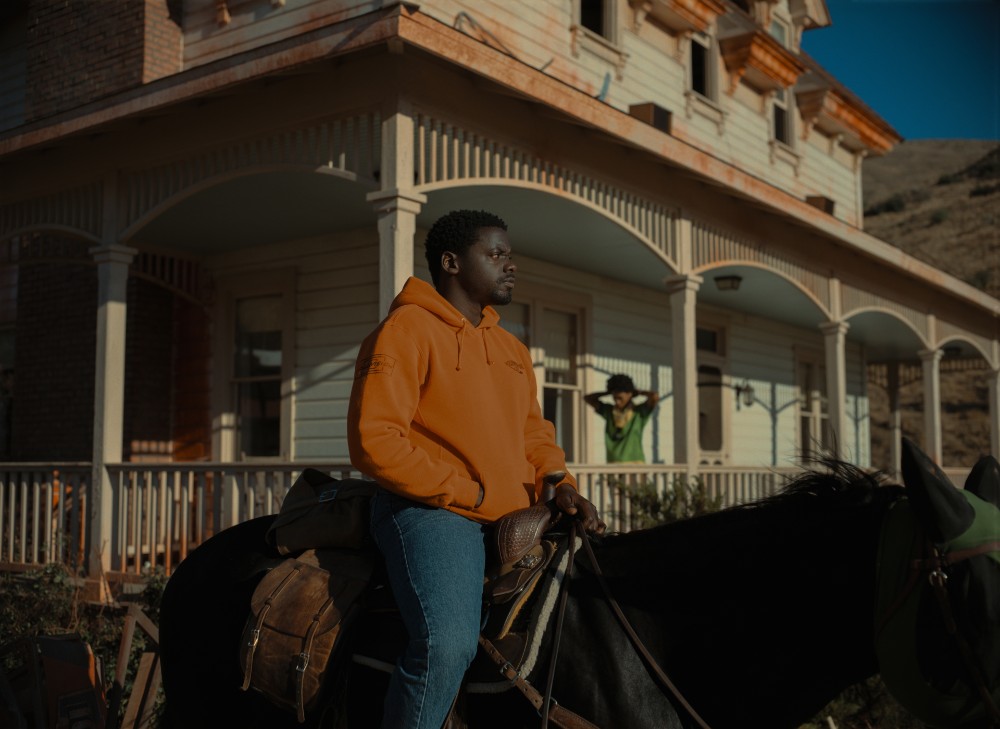
When a filmmaker like Jordan Peele who’s coming off back-to-back hits — Get Out and Us — is ready to make their third movie and hire their department heads, they can literally call upon almost any below-the-line worker they want, from award-winning veterans to industry newcomers.
When it came to designing Nope, Peele’s new UFO, or rather, UAP (Unexplained Aerial Phenomena) movie, he called up Ruth De Jong, his Production Designer on Us, to find, create, and build the environment for his latest genre story (and box office champ).
Nope revolves around brother and sister O.J. and Emerald Haywood (Oscar winner Daniel Kaluuya and Keke Palmer), who are left to deal with their late father’s horse ranch, where he trains the majestic animals for film and television productions. One day, O.J. sees a strange object in the sky, and he and his sister decide to try to capture it on film with the help of a Fry’s Electronic store clerk named Angel (Brandon Perea) and a cinematographer (Michael Wincott) who claims to be able to capture anything on film.
Peele’s third feature is an “alien invasion” movie like none other, but it’s also a bit of a love letter to old-school filmmaking even though he used very modern technology, including IMAX cameras, to film the locations that De Jong designed.
Below, you can read the fascinating conversation Below the Line had over Zoom with De Jong about what went into designing the unique locations in this story. She also discussed working with Cinematographer Hoyte van Hoytema, with whom she’s working once again on Christopher Nolan’s Oppenheimer, which is currently in production for a 2023 release.
[Note: There may be some very minor Nope spoilers in this interview, although we keep things generally vague for those who haven’t seen the film yet.]
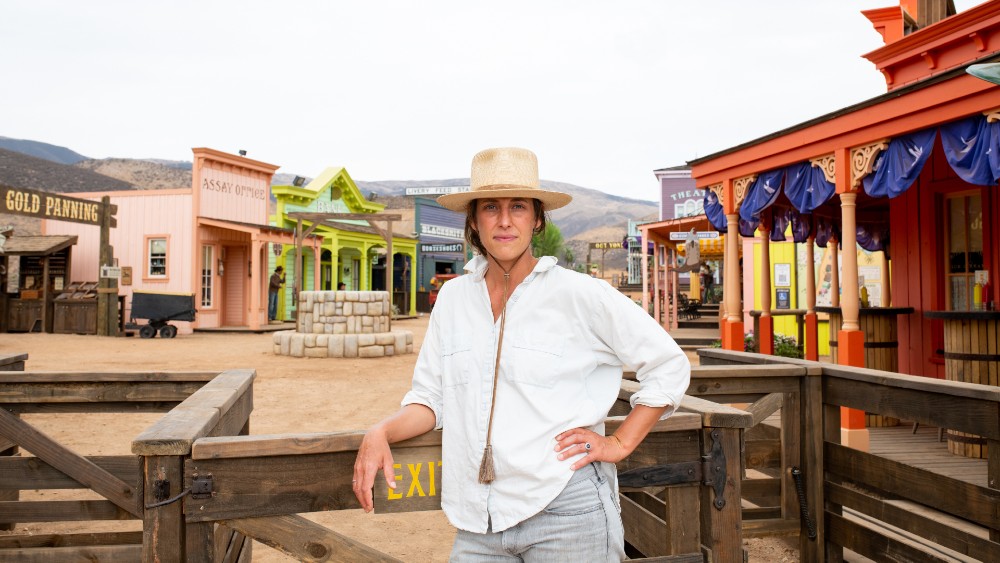
Below the Line: Us came out in 2019 before the pandemic hit. At what point did Jordan come to you and say, ‘I think I have my next movie, and it will be…’
Ruth De Jong: Shortly after that, we were kicking around a different movie, actually, than this one, and then, it came to that he was gonna pivot and focus on what is today [called] Nope. It had many iterations, and I think we had such a great experience together on Us and wanted to continue to world-build together. I just have so much respect for Jordan and his work and his mind. He was ready to really push it and world-build, and I jumped right in. Early on, I would say a year and a half before we started physical production, we started, back and forth, I was deep-diving [into] all kinds of research, as he was formulating the concept for Nope. I didn’t even have a script, initially. It was conversations and then initial passes until it was like, a year later, that I actually got a script.
BTL: Were these conversations even before the pandemic started? Had COVID hit at that point?
De Jong: Yeah, loosely before the pandemic — nothing serious — but then during the pandemic, we dove in and really went deep, but not sure when we were going to go or what was going to happen, and then, it really ramped up I would say, like, September 2020. We really dove in deep and then we didn’t really start physical production until, I want to say, February 2021.
BTL: Did you know right away that you’d have to build the Western town, at least, and did you find the ranch or did you just find the location and build something there?
De Jong: Fiscally, I think it was desired that we find a Western town, budgetarily speaking. I think as Jordan was defining his desires for this picture, it was like, ‘No, I am building this town from the ground up.’ I immediately went into research on, like, looking at Bonanza. I’ve worked on There Will be Blood, Heaven’s Gate, Once Upon a Time in the West. All these film Western towns, and their definition of Americana, as well as practical Western towns throughout Nevada, Montana, Idaho, all through California. We took a field trip to Knott’s Berry Farm, then a bunch of pioneer towns. We knew we wanted it to be a classic American frontier Western town, but it needed to be a theme park, and it needed to be from [the] POV of Jupe [the character played by Steven Yeun].
The context originally came from Jupe wanting to riff off of Kid Sheriff, that movie he was in, and recreate the town from Kid Sheriff. He can’t do that, because he doesn’t own the rights to Kid Sheriff, so we needed to create an “off town” enough to be Jupe’s, that he entirely owns, and that is how we invented [it]. It was so much fun because you could write your own rules, and [include] all this influence from the American West and folks that had done theme parks. And then, Jordan really made it his own, [and] I mean entirely. Going down rabbit holes on that was epic, it was so much fun.
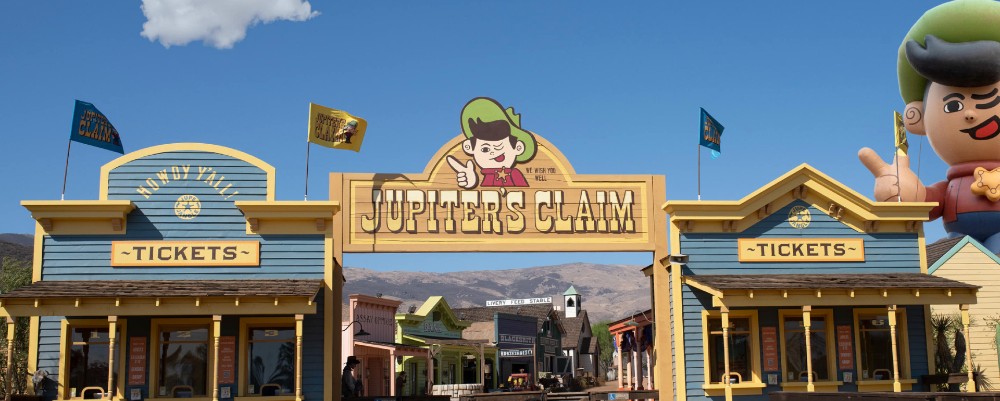
BTL: Was it made up entirely of facades or were there actual buildings that the actors could go inside?
De Jong: You could go in and out of everything, and Jupe’s office was fully practical, so that building, when you walk in, you can go up to the second [floor]. It was all physically there. We built everything 360 — the stadium ground up, the house ground up. It was a huge blessing to give Jordan and Hoyte van Hoytema the privilege to shoot 360, however they wanted. Obviously, we worked on layout very closely directional, kind of how the town was laid out, where the house is laid out, the fact that it was facing over the valley. These two ranches were right next to each other out in Agua Dulce, Santa Clarita area.
A random side note, we had no idea, but the ranch where we built the main hero house, Haywood ranch, and built the horse stadium and the shed, that was William Mulholland‘s former ranch in the late turn of the century, and where we built Jupiter’s Claim was Howard Hughes‘s old ranch. It had actually burned down. All that was left [were] the 100-year-old olive trees and those kind of lined the stadium. It was so trippy to know that, and very random. They were just two pieces of land that we built our worlds out of.
BTL: This was all California, so was it central enough that everyone could go home at night after filming?
De Jong: Everybody went home, and actually, in real life, most of the tradespeople live up there — the prop makers, the animal wranglers, their ranches. Our animal wranglers’ physical home was 10 minutes away from these sets. It’s about an hour outside of LA — it’s about 45 minutes from Universal Studios to where we were shooting. You just go north up the 5 to the 14, and you’re out in this desert. There are a lot of movie ranches up there, and it’s an area that Hollywood typically goes to film, but these were two private properties that we commandeered and utilized for our picture. It was nice to be able to have just the land and then create the world exactly as we wanted to do it, and geographically connect them.
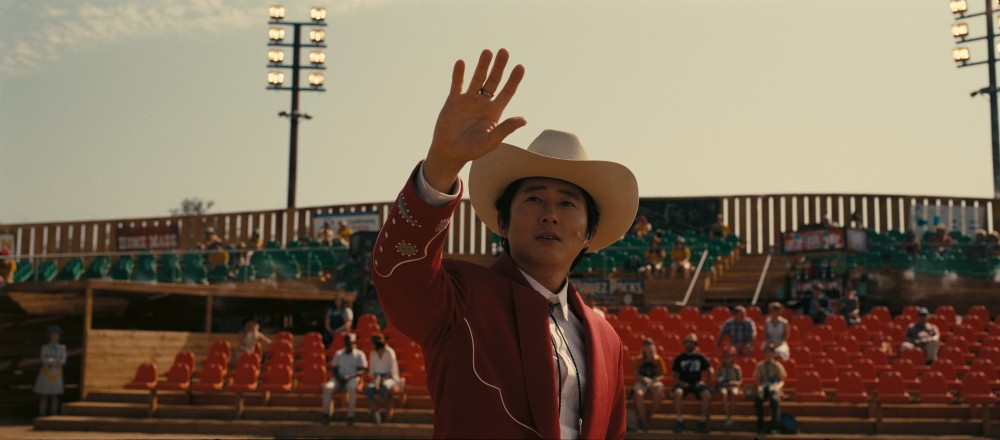
BTL: How did you work with Hoyte in terms of making sure the indoor locations had enough space for him to film what he needed to do? Did you still have the ability to take down walls and things like that?
De Jong: We did, but Hoyte is so incredible. He’s a purist. For instance, you know the scene after the commercial has failed, and Otis Jr. goes into the porta-potty and is having a moment? We were gonna build a porta-potty, we were gonna take the roof off. Hoyte was just like, ‘Let’s just open the door, and I’m gonna stick the camera in there.’ It just went back to, like, ‘No, we’re not doing some crazy set piece. We’re just going to use this porta-potty. We’re gonna open the door, and I’m gonna stick the 65mm [camera] in there and shoot it.’ That’s similar to how we did the hero house.
What I love about Hoyte is he’s an amazing collaborator. [It wasn’t like], “Oh make the ceiling fly away…” No, I could do hard ceilings everywhere. In Jupe’s office, I had a wall that could [move]… but he never took it out! I think it really grounds the film, because you have these practical, physical locations that we built for real, and he shoots them as though they’re permanent and real. I’m trying to think if there was an area where he… not off the top of my head. I mean, the barn, the stables, all that stuff, he shot it practically.
BTL: Even with the larger IMAX cameras, he was able to bring them indoors, or did he just use those to shoot the outdoor stuff?
De Jong: Both indoor and outdoor. He’s amazing. He’s not precious, and also, the way he looks at lighting and treats lighting, I think he’s the only DP… it’s incredible how it could be 12 noon, and [I have worked with] DPs that are like, ‘We are not shooting right now.’ Hoyte’s like, ‘Let’s go. We’re shooting this light.’ He’s not scared of anything, nor is he scared of it being ugly. There’s just such a rawness and realness to his work that’s incredibly inspiring. So, it was a good match.
BTL: Did he storyboard or block stuff? He must have done some of that stuff once he got to the set, right?
De Jong: Jordan storyboards. Jordan loves to storyboard, and we did storyboard and we also free-flowed a lot. You’re out there and you feel it, and it’s guttural, and you are figuring out the shots. When you have such a vast world to work with, sure, you can storyboard it, but then at some point, you just have to lean into what’s right there in front of you. Us, we storyboarded to a tee. Like every shot, it was just like, ‘Here’s what we’re doing.’ We did start the movie that way, and Jordan likes to have that sense of organization. Just getting all the stunt sequences, everything was storyboarded, but then, I think there was also that space that allowed for him and Hoyte to evolve the storyboards as they desired.
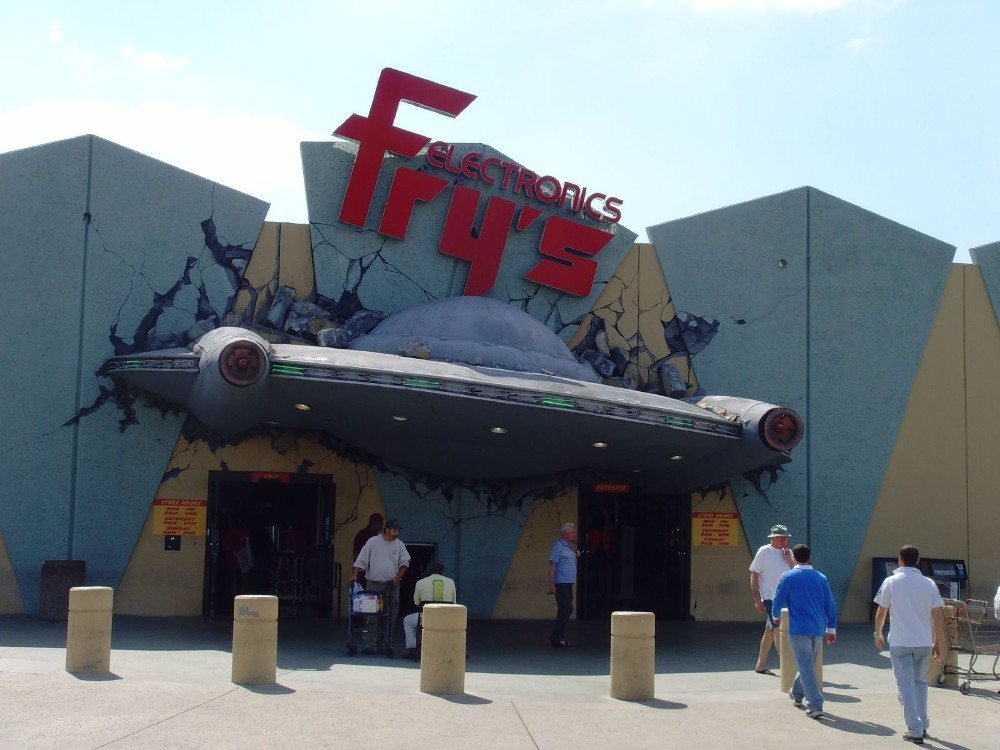
BTL: Was Fry’s Electronics entirely built on a soundstage or was that another electronics story that you repurposed?
De Jong: Fry’s is a real California quintessential iconic store. If you Google the history of Fry’s, it was so surreal, because Fry’s are peppered all over L.A. There’s one in Burbank, and the Burbank store is the one we shot, and they all have very specific, crazy… it’s like they’re out of a Jordan Peele film, with set builds inside of them. The owner, Randy Fry, had created… one of them was all Alice in Wonderland. Long story short, Jordan is like, ‘We’ve gotta go with Fry’s. It’s so iconic to Southern California.’ We started production, and then, in the newspaper, it was like, during the pandemic: “Fry’s Closing All Stores.”
I remember the day — it was like November 4th, and I called our UPM [Unit Production Manager] Paul Jordan and was like, ‘Fry’s is closing.’ We had scouted the building, worked it out, been in communication with them, and then all sudden, they’re like, ‘We’re liquidating all of our stores.’ And we’re like, ‘Wait! Is there any way we can hold this Burbank store, and Randy Fry worked with us. He lives up in San Francisco, and his son managed the Burbank store. [Randy] physically owned that property, that building itself, the whole thing; it’s next to the Burbank Airport. He had to liquidate a lot of things inside, so my set dressing team [led by Set Decorator Gino Serdena] had to fill the store again, which was painful, but just a big dress with all the appliances and a lot of it was boxes and that sort of thing, but we shot in the physical store. We did some set pieces, like the mountains and different things, but we were able to at least capture some of it.
I think for a minute Jordan was like, ‘Oh, it’s closing. Let’s just pivot to a fake…’ and I’m like, ‘No. This will go down in history…’ Fry’s is like… I don’t know what the equivalent is in New York.
BTL: Maybe Best Buy?
De Jong: No, because Best Buy is a generic box store that came later. Fry’s goes back a long time, and everyone… before Apple came out with iPhones, Fry’s was like the big Radio Shack where you went and got the new… they had records, tapes, all the way up. Google Fry’s and you’ll get the history on it, but pretty much everybody on our crew had a Fry’s memory of being 10 years old and getting their first record or tape or DVD or whatever. So now, it lives on, so I’m glad that we could forever just have a piece of Fry’s in the picture, so that’s real.
BTL: How involved were you with designing “Jean Jacket”? I’m not sure what else to call it, because I don’t want to spoil anything.
De Jong: Jordan and our VFX Supervisor Guillaume [Rocheron] really created that. Early on, I was involved in the conceptualization of it. We researched a lot of deep sea creatures that lived way, way under the ocean, and looked at their movements and how they opened and the things they did when they were showing off for a mate or when they were eating or killing or whatever they were doing. The whole thing was based on deep sea creatures, and we talked a lot about what it is and the representation of it, but then Guillaume and Jordan went deep. Guillaume’s team began taking this research to mood boards and drawing it, and then, there were many, many, many, many iterations for a very long time.
BTL: Did visual effects LIDAR the entire ranch and stadium into the computers in order to achieve some of those shots with Jean Jacket?
De Jong: Yes, the ranch and Jupiter’s Claim.
BTL: Is a lot of the background stuff we see from the ranch, like the mountains, is that all still there, or did they add some of that in visual effects?
De Jong: It’s all practical; it’s all real. It’s all there, and that trip from the main house down, when Em rides her motorcycle, that’s totally connected, and you can go from there into the theme park. We wanted to keep it as grounded as possible.
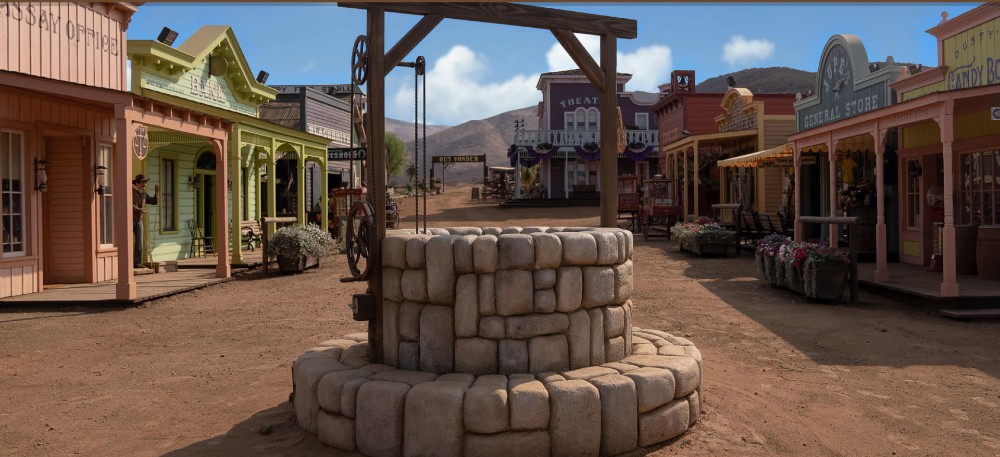
BTL: That camera in the “winking well” in Jupiter’s Claim, is that a real thing that exists in real life? Is that something you might see at a real theme park?
De Jong: No, we created it. We built it from scratch. It was completely mechanical, meaning no electricity, so we were going back, and I was looking at the big format cameras from the 1800s when you put [the cover] over it. We were thinking, “At a theme park, how do they get the film so quickly?” and that’s 8X10 Polaroid film, so we used a combination of a large format, mixing with a Polaroid camera. We completely custom-built it. Hoyte helped me, and then Scott Fisher, our Special Effects Supervisor, we welded and built the whole under part, and we bought a field camera, and then on the back of the field camera we attached a Polaroid with 8X10 Polaroid film. We needed to be convincing, and then we electrified those bulbs, those were just flashbulbs. You have to replace them after you go through them all.
BTL: I read that Jupiter’s Claim is being moved to Universal Studios, so how much of it is going over there?
De Jong: It’s all there. Go to JupitersClaim.com, and that’s Universal’s website for it. It opens tomorrow when the film opens. The tram ride will go through it and the wishing well is there, and the panning for gold, the petting zoo. The front entrance “Welcome to Jupiter’s Claim,” the big Jupe ballon is there, [and] the stadium in shambles is there. You go through, and I think VIPs can get off and interact with the town. It’s smack in-between the Tom Cruise plane crash from War of the Worlds, and Fast and Furious.
BTL: I think you’ve convinced me to go there the next time I’m in L.A., but the stadium was destroyed as part of the story, so did you rebuild that at Universal?
De Jong: They wanted it to be destroyed. We didn’t have the acreage to put it at Universal because we had a very specific plot. Universal Studios has a theme park crew that builds their theme parks, so they came up and worked with my crew, and we closely made a drawing of our town that would fit in this plot. They came up and stripped all the facades and buildings and then rebuilt it there. So, they had all the facades and then they rebuilt it to fit their deal. There wasn’t enough space for the entire stadium.
Nope is now playing in theaters nationwide as it continues to roll out across the globe.





